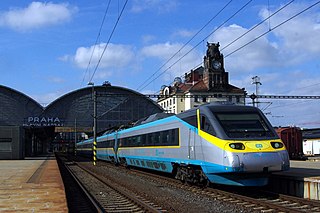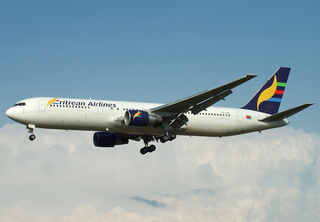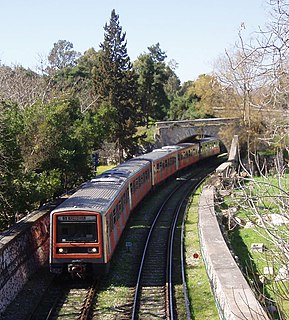This article needs additional citations for verification .(August 2018) |

Transport infrastructure in Guinea-Bissau is basic, with most roads outside the capital Bissau being unpaved.
This article needs additional citations for verification .(August 2018) |

Transport infrastructure in Guinea-Bissau is basic, with most roads outside the capital Bissau being unpaved.
There are no railways in Guinea-Bissau. At the Port of Bissau, there was a small cargo railway working from the late 19th century into the 1940s.
In 1998 an agreement was signed between Portugal and Guinea-Bissau for construction of a railway to Guinea, [1] [2] but the outbreak of the Guinea-Bissau Civil War in 1998 made these plans impossible.
The Trans–West African Coastal Highway crosses Guinea-Bissau, connecting it to Banjul (the Gambia), Conakry (Guinea), and eventually to 11 other nations of the Economic Community of West African States (ECOWAS).
Several rivers are accessible to coastal shipping in Guinea-Bissau.
In 1999 no merchant vessels were operating.
The main airport serving the country, and the only one with scheduled commercial service, is Osvaldo Vieira International Airport in Bissau.
Paved runways:
Over 3, 047 m:
1,524 to 2,437 m:
914 to 1,523 m:
Unpaved runways:
1,524 to 2,437 m:
914 to 1,523 m:
under 914 m:

Modes of transport in the Central African Republic include road, water, and air. Most but not all of the country is connected to the road network, much of which is unpaved, and which centres on the routes nationales identified as RN1 to RN11. Bangui serves as a seaport, and 900 km of inland waterways are navigable, the main route being the Oubangui river. There is one international airport at Bangui-Mpoko, two other paved airports, and over 40 with unpaved runways.

Transport in the Czech Republic relies on several main modes, including transport by road, rail, water and air.
Transport in Djibouti is overseen by the Ministry of Infrastructure & Transport. Over the last years, the Government of Djibouti have significantly increased funding for rail and road construction to build an infrastructure. They include highways, airports and seaports, in addition to various forms of public and private vehicular, maritime and aerial transportation.

Transport in Eritrea includes highways, airports and seaports, in addition to various forms of public and private vehicular, maritime and aerial transportation.
Transport in Ethiopia is overseen by the Ministry of Transport and Communications. Over the last years, the Ethiopian federal authorities have significantly increased funding for rail and road construction to build an infrastructure, that allows better economic development.
Modes of transport in Fiji include rail, road, water, and air. The rail network is mainly used for movement of sugar cane. Suva and Lautoka are the largest seaports. There are 122km of navigable inland waterways. There are two international airports, one other paved airport, and over 20 with unpaved runways. With 333 tropical islands that make up this country, one can expect to use various modes of transport to get to their destination.
Railways: 0 km
Railways: 0 km
Modes of transport in Gabon include rail, road, water, and air. The one rail link, the Trans-Gabon Railway, connects the port of Owendo with the inland town of Franceville. Most but not all of the country is connected to the road network, much of which is unpaved, and which centres on seven "national routes" identified as N1 to N7. The largest seaports are Port-Gentil and the newer Owendo, and 1,600 km of inland waterways are navigable. There are three international airports, eight other paved airports, and over 40 with unpaved runways. Nearly 300 km of pipelines carry petroleum products, mainly crude oil.

Transport in Greece have undergone significant changes in the past two decades, vastly modernizing the country's infrastructure and transportation. Although ferry transport between islands remains the prominent method of transport between the nation's islands, improvements to the road infrastructure, rail, urban transport, and airports have all led to a vast improvement in transportation. These upgrades have played a key role in supporting Greece's economy, which in the past decade has come to rely heavily on the construction industry.

Transport in Guinea is composed by a variety of systems that people in the country use to get around as well as to and from domestic and international destinations. The railway from Conakry to Kankan ceased operating in the mid-1980s. Most vehicles in Guinea are 20+ years old, and cabs are any four-door vehicle which the owner has designated as being for hire. Domestic air services are intermittent. Conakry International Airport is the largest airport in the country, with flights to other cities in Africa as well as to Europe.
Transport in Hungary relies on several main modes, including transport by road, rail, air and water.
This article provides an overview of the transport infrastructure of Latvia.

Transportation in Malawi is poorly developed. The country of almost 14 million has 39 airports, 6 with paved runways and 33 with unpaved runways. It has 797 kilometres of railways, all narrow-gauge and about 45 percent of its roads are paved. Though it is landlocked, Malawi also has 700 km (435 mi) of waterways on Lake Malawi and along the Shire River.

Railways: 0 km
This article describes the transport in Peru.
Transport in São Tomé and Príncipe relies primarily on road infrastructure for local needs and airports and sea travel for international needs. São Tomé and Príncipe does not have railways.
Most internal transport in Solomon Islands is conducted through boat travel between islands. Road transport infrastructure is rudimentary, with few paved roads.

Vanuatu's undeveloped road system, with fewer than 100 miles of paved roads, consists mostly of dirt tracks suitable only for four-wheel-drive vehicles. Every island has one or two short airstrips where Vanair’s Twin Otter planes land two or three times weekly. In addition, every island has a small port or wharf where small cargo ships and boats regularly dock.